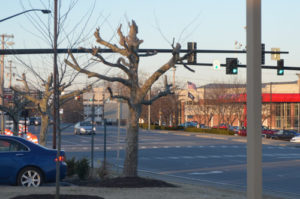It is amazing to me that trees are treated with such little regard. They are very important in the cleansing of the air we breathe and yet, they are abused. Poor planting, over mulching, forgetting to remove the planting stakes and wires, chopped and badly pruned, driven into, pulled on, leaving the wire basket and burlap sacking on when planting all add up to trees that probably won’t make it past the five or ten year mark, and that is a real shame. Not only for the investment by the homeowner, locality or council but for the tree itself never being able to realize its full potential. So often we now see large homes being built with no trees close to the building for shade. The street trees that either destroy the walkways with large roots that impact pipelines and necessary services or grow into the overhead lines and require such drastic pruning that it distorts the beauty of the tree. There is another way…plant the right tree to suit the space. Here are some examples of what not to do:
The pin oaks shown in this picture typically reach 60-70’ tall and have a canopy reach of 30-45’. The question is why would you plant two of them twenty feet apart in front of a shop, when everything around is either concrete or asphalt and then when they get too big do this to them?

The American sycamores shown in this picture can reach upwards of 130’ with trunks obtaining up to 6’ in diameter and canopies spreading out to 100’. Having seen these trees in their natural habitat it is amazing that they are even considered for street trees (apart from their ability to overcome pollution by exfoliating their bark). The picture below clearly shows that the wrong choice was made when choosing these trees.

If you are unfortunate enough to have overhead lines running through your garden it is worth talking with the service provider to see if they can bury the wires. I had a great conversation with a representative from our local energy co-op and he was very receptive to the thoughts I had for our home here in Winchester. We intend to bury the lines not only coming into our property but part of the way down the shared driveway to negate having to prune the small group of trees that lines the drive. It saves the energy company money in the long run as they don’t have send a crew out every few years when the trees grow back into the lines and it stops us from having frequent power cuts due to branches touching the lines.
Good choices for trees if you cannot bury the lines include:
- Crab apple (Malus sp.) – height ranges between 8’to 25’
- Crape myrtle (Lagerstroemia) – heights ranges between 6’ to 30’
- Hawthorne (Crataegus) – height ranges between 20’ to 30’
- Mountain ash (Sorbus) – height ranges between 20’ to 30’
- Carolina silver bell (Halesia) – typically up to 30’ but in the Appalachian mountains it can reach 80’
- American hornbeam (Carpinus) – height ranges between 25’ to 30’
- Amur maple (Acer) – height ranges between 15’ to 25’
There are countless other trees but these are some of the one I would recommend, some of them flower, most have great autumn colour, some have berries for wildlife and they all have the potential to be better trees for awkward spaces.